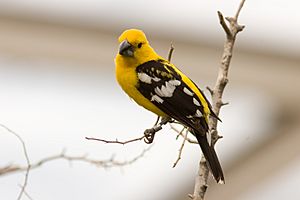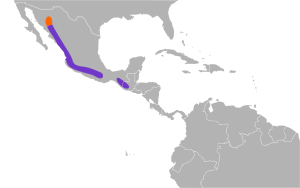Yellow grosbeak facts for kids
Quick facts for kids Yellow grosbeak |
|
|---|---|
 |
|
| Adult male at Burgers Zoo | |
| Conservation status | |
| Scientific classification | |
| Genus: |
Pheucticus
|
| Species: |
chrysopeplus
|
 |
|
The yellow grosbeak (Pheucticus chrysopeplus) is a cool, medium-sized bird. It's also known as the Mexican yellow grosbeak. This bird loves to eat seeds! It belongs to the same bird family as the famous northern cardinal. This family also includes "tropical" buntings and other "New World" grosbeaks.
Contents
Where Yellow Grosbeaks Live
The yellow grosbeak lives along the Pacific coast of Mexico. You can find it from central Sonora to northwestern Oaxaca. It also lives in southern Chiapas and Guatemala. In Sonora, these birds are migratory. This means they travel to different places during the year.
Scientists once thought this bird was the same as the Black-thighed grosbeak and the Southern yellow grosbeak. But now they are considered different species. Yellow grosbeaks mostly live in trees in forests and woodlands. They like the edges of forests best. You usually won't find them in very thick rainforests or cloud forests.
Sometimes, a yellow grosbeak might fly far from its usual home. These birds are called "vagrants." They have been seen in the United States. Most often, they appear in summer in Arizona. But they have also been reported in California, Colorado, New Mexico, and even Iowa.
What Yellow Grosbeaks Look Like
The yellow grosbeak is bigger than its relatives in North America. These include the black-headed grosbeak and the rose-breasted grosbeak. The yellow grosbeak is about 21.5 to 24 centimeters (8.5 to 9.4 inches) long. It weighs around 62 grams (2.2 ounces).
This bird has a very large head. Its gray-black beak is huge compared to its head. It's even bigger than the beaks of its northern relatives.
The feathers of the yellow grosbeak have bright colors. They are a mix of yellow, white, and black or gray.
Male Yellow Grosbeaks
Male yellow grosbeaks have a solid yellow head and belly. In most places, this yellow is a light lemon color. But in Chiapas and Guatemala, the males are a "brilliant golden-orange." Their back is black with yellow spots. The rump (the area above the tail) is yellow. The feathers covering the top of their tail are black with white tips. Their wings and tail are black. They have clear white spots, patches, and stripes on their wings.
Female Yellow Grosbeaks
Female yellow grosbeaks look similar to males. But their upper parts are more olive-colored. They have dark streaks on their head and back. The black colors on males are replaced by gray on females. The white markings on their wings are also smaller. This is especially true for the white area at the base of their main wing feathers.
Female yellow grosbeaks look a lot like female flame-colored tanagers. But grosbeaks are much bigger. Their beaks are especially larger. Young yellow grosbeaks look like the females.
Sounds and Songs
Yellow grosbeaks make different sounds. A common call is a metallic iehk or plihk. This sounds like calls from other Pheucticus grosbeaks. They also make a soft whoi or hu-oi sound. You can often hear this sound when they are flying.
The song of the yellow grosbeak is a rich, warbling sound. It changes a lot. It sounds a bit like the song of the black-headed grosbeak. But the yellow grosbeak's song is shorter.
Reproduction and Nests
Like other birds in its group, the yellow grosbeak lays two to five eggs. The eggs are pale bluish to greenish. They have many brown and gray speckles.
The bird builds a cup-shaped nest. It places the nest at a medium height. You can find these nests in a bush or a small tree.
See also
 In Spanish: Picogrueso amarillo para niños
In Spanish: Picogrueso amarillo para niños


